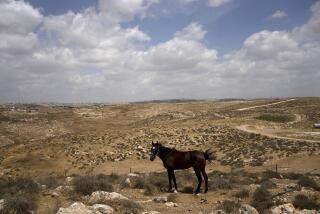Tiny Battle Is a Big Symbol in the Galilee
RAS EL EIN, Israel — The creek known as Nahal Tsalmon has nourished wheat fields and olive groves, pushed mill wheels and provided a cooling oasis for the mostly Arab residents around it here in the rural Galilee.
But a bitter standoff also has played out along its stony banks.
Since the 1980s, Israeli officials have wanted to develop a national park around the stream but have been unable to do so because Arab families live inside the proposed boundaries. Israeli officials called the homes illegal, but owners refused to leave land they had held since before Israel was a state.
With the help of U.S.-trained mediators, the two sides reached an unusual agreement last month that should allow the 900-acre park to be built and the half-dozen homes to remain inside.
In a land of outsize conflict, it is a tiny triumph. But the agreement itself may be less significant than the means used to reach it: Perhaps for the first time, a public dispute over land in Israel has been solved through mediation.
Those who took part say the pact, aimed at promoting nature while leaving room for dwellings, may open the way for using intermediaries in other land and environmental disputes around the Israeli countryside.
Although the United States and other countries have long employed mediation in land-use battles -- over where to build waste dumps or shopping malls, for example -- Israel has used it mainly in private disputes, such as between spouses or rival business owners.
“It’s not a common thing,” said Amitay Har Lev, an Israeli environmental planner who joined two other mediators in brokering the Nahal Tsalmon agreement over nearly three years.
Har Lev said his team was met with deep skepticism and even hostility from officials of various Israeli land-planning agencies who initially saw mediation as a threat to their authority, and mistrust from residents who suspected a government ploy.
“There is no culture of mediation” in Israel, Har Lev said. “The Israeli culture is tremendously different from the U.S. culture. We tend to be more competitive. We know how to use force.”
Forging the park agreement was particularly tricky, mediators said, because of long-running tensions between Jews and Arabs over land in the Galilee, a hodgepodge of established Arab villages and newer Jewish towns that have sprouted with the help of the Israeli government.
“This is not just an environmental dispute. It’s also an Arab-Jewish dispute that has a long, long history,” Har Lev said. “Though it wasn’t on the table, it was there.”
Har Lev was one of two Israeli Jews on the team; the third mediator was Jalal abu Toameh, an Israeli Arab who once served as mayor of the village of Baqa al Gharbiya, 60 miles to the south.
The men were part of a group of 10 Israelis who, along with 10 Palestinians, were trained as mediators by the Consensus Building Institute, a nonprofit group based in Cambridge, Mass. Classes began in the summer of 2000, in hopes that trainees would jointly tackle environmental and land conflicts between Israelis and Palestinians.
The outbreak of the intifada months later killed hopes for joint projects. Instead, the Israelis turned to the Nahal Tsalmon standoff for their first test.
Officials and some homeowners said they were wary at first because they knew little about mediation. Darkening prospects was the long enmity between the people who lived and farmed inside the proposed park’s boundaries and the agencies involved in the plan, including the national parks authority, lands administration, environment ministry and regional planning office.
“I thought that the differences between the two sides were too great and that it would be very difficult to build a bridge over them,” said Yigal Viner, chairman of the agency that oversees national parks. “But I was wrong.”
Jamil Nikola, a 51-year-old woodsman who was the first homeowner approached by mediators, said his extended family was opposed to participating.
“Everybody was against it,” he said. “But I convinced them to go along.”
There were meetings, further meetings and still more meetings. The sessions were conducted in Hebrew, with Arabic interpreters. Arguments broke out occasionally, and at one point, an influential environmental group quit. One of the Arab residents vowed at each meeting that it would be his last, but he kept showing up, Abu Toameh said.
Slowly, mistrust gave way to fruitful discussion as Israeli officials laid out their 20-year-old plans for the park, which residents said they had never been shown. The two sides began to envision an uncommon arrangement: a national park with private homes inside.
Under the resulting agreement, signed July 8 in a eucalyptus grove, homeowners will allow hiking trails through their properties, along the creek past cucumber fields and citrus groves. Residents are to be given the first crack at park jobs and opening a restaurant.
Reservations about the deal remain, however. It still must be put into practice, and Israel’s Interior Ministry, which did not sign the agreement, must approve final plans.
Some Israeli officials complain that the government was too quick to bend to reach accommodation. Both sides are bracing to see whether mediation proves a breakthrough, or a broken promise.
Although the park fight may be small, its stakes are not, the mediators say.
“This is a symbol of the problem between Arabs and Jews in Israel and Palestine,” Abu Toameh said. “The Arab feels they want to throw him out of his home. And the Jews feel that the Arabs are against them, hate them and want to take the land of the state.
“The size of the problem is small, but it’s symbolic.”
More to Read
Sign up for Essential California
The most important California stories and recommendations in your inbox every morning.
You may occasionally receive promotional content from the Los Angeles Times.










